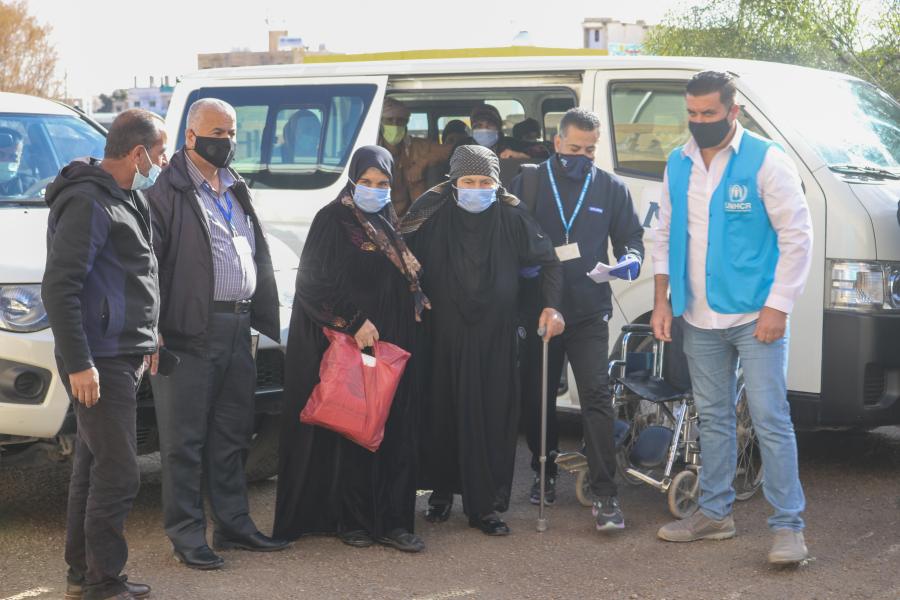2021 Year-end population figures
-
Refugees in neighbouring countries (including Türkiye): 5.7 million
- IDPs: 6.9 million
- Refugee returns in 2021 alone: 36,000
- IDP returns (according to OCHA): 169,000
2021 situation overview
The decade-old Syrian Arab Republic crisis remained the world’s largest displacement crisis. By the end of 2021, more than 5.7 million Syrian refugees were displaced in neighbouring countries and 13.4 million Syrians were estimated to require some form of humanitarian and protection assistance inside Syria, including some 6.9 million internally displaced people (IDPs). People’s ability to meet their basic needs decreased as COVID-19 brought significant economic and social distress, on top of the effects of the ongoing conflict, inflation, and existing sanctions.
Inside Syria, UNHCR addressed significant humanitarian needs through multisectoral assistance and strengthening its community-based protection approach. As part of the whole-of-Syria response, UNHCR co-led the protection, shelter, and non-food items and camp coordination and camp management cluster responses.
More than $266 million in cash assistance was distributed to close to 4 million Syrians in need and 285,000 vulnerable Syrian families received core relief items, helping to meet basic needs and mitigate harmful coping mechanisms such as reducing food consumption and child labour. More than 75,000 essential secondary and tertiary health care referrals were supported. Legal assistance was provided to some 483,000 Syrian refugees, IDPs and returnees and 31,500 Syrian refugees were assisted with civil status registration or documentation. In response to the harsh winter conditions, more than 2.1 million Syrians received cash assistance or core relief items to help them address seasonal needs such as heating.
Durable solutions for Syrian refugees are based on a comprehensive protection and solutions strategy seeking to:
- support the host country and community resilience;
- enable refugee self-reliance, including access to services, legal work opportunities and livelihoods;
- expand access to resettlement in third countries and other complementary pathways, anD
- plan for the return of refugees to Syria, on a voluntary basis, when conditions for a safe, dignified and sustainable return are in place.
UNHCR worked to expand local opportunities and solutions for Syrian refugees, co-leading with UNDP the Regional Refugee and Resilience Plan (3RP) in response to the Syria crisis, coordinating the work of more than 270 partners in support of national efforts in Egypt, Iraq, Jordan, Lebanon and Türkiye. The 3RP connected the response with longer-term national strategies for inclusive growth and sustainable development.
UNHCR has identified over 610,000 Syrians as being in need of resettlement. In 2021, more than 17,000 Syrians departed for resettlement from the region, up from 9,400 in 2020 (but down from an average of 23,500 in 2018–2019).
In 2021, UNHCR registered around 36,000 returns, a decrease from 38,000 in 2020 and 94,000 in 2019, likely as a result of the challenging conditions inside Syria and the impact of COVID-19. A March 2021 intention survey found that while most Syrians outside Syria wished to return one day (70%), few planned on doing so in the next 12 months (2.4%). Respondents cited safety and security, livelihood opportunities, and housing and basic services as barriers to returning.
UNHCR provided multisectoral support where spontaneous refugee and IDP returns took place and engaged with the Government of Syria to advocate for legal, administrative and other measures to address obstacles to return. UNHCR adopted an area-based approach inside Syria, to support sustainable reintegration and recovery. This included concrete and practical interventions in areas such as shelter, protection services including legal aid and civil documentation, distribution of relief items, and restoration of basic services, among others.
